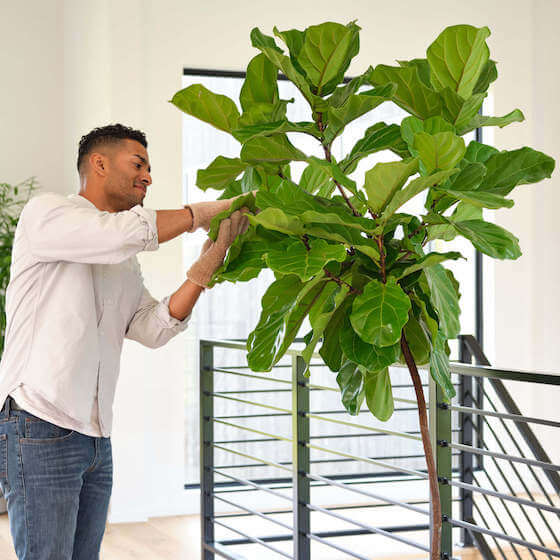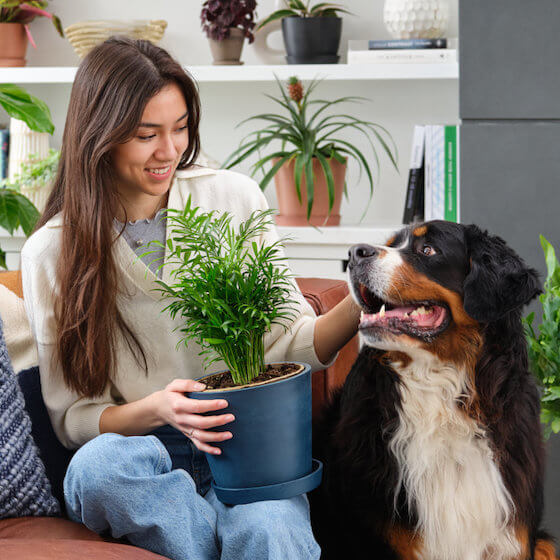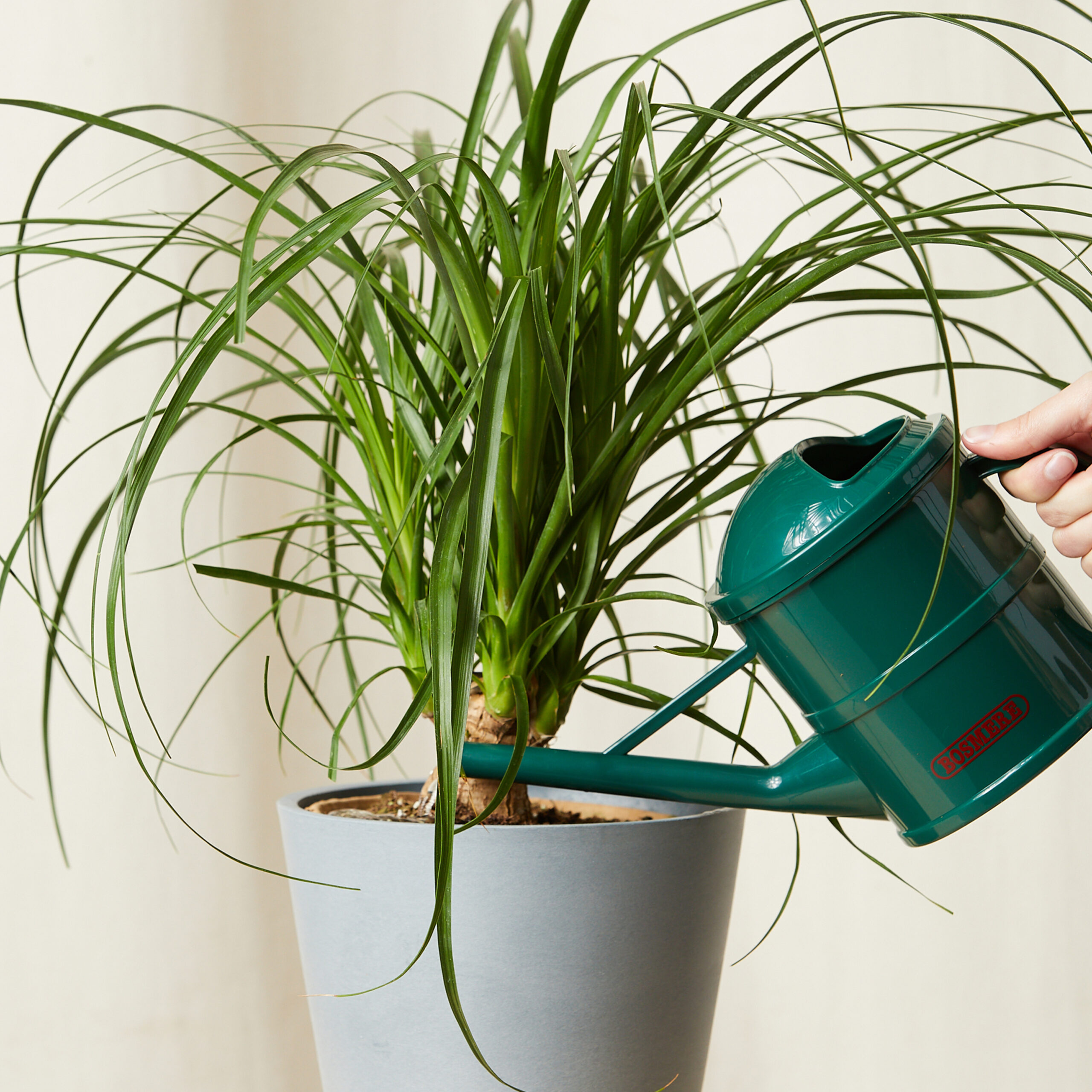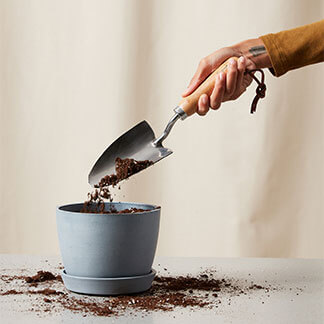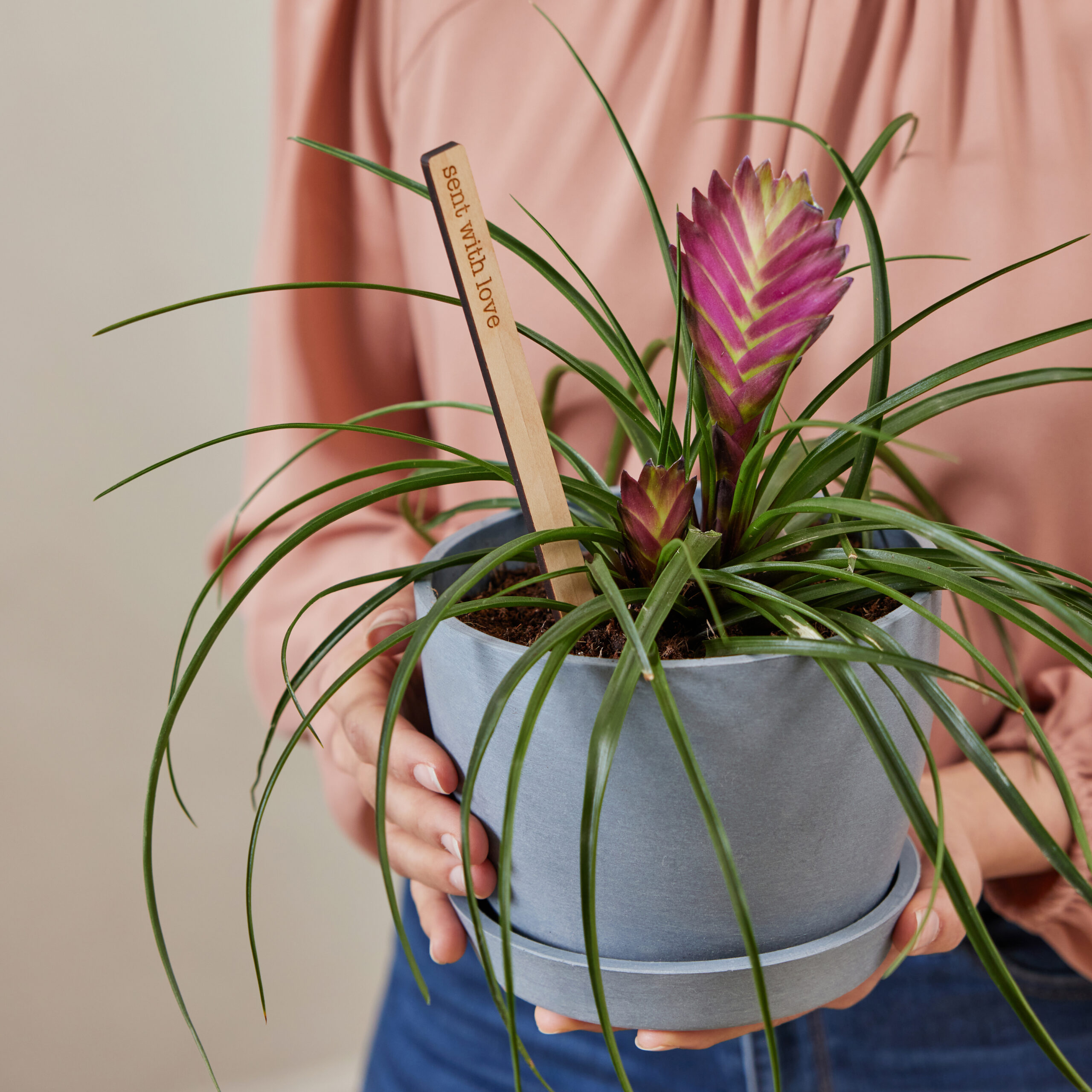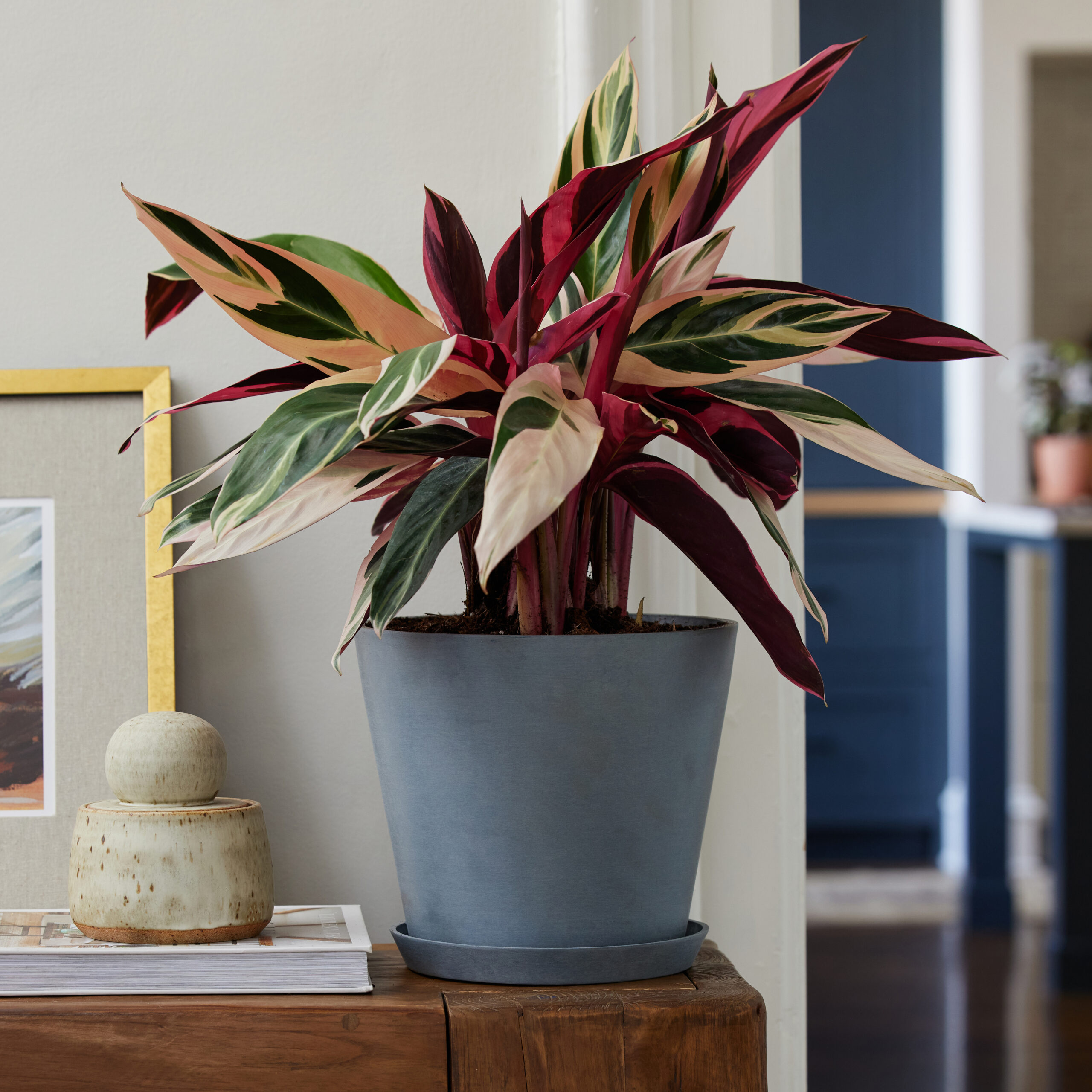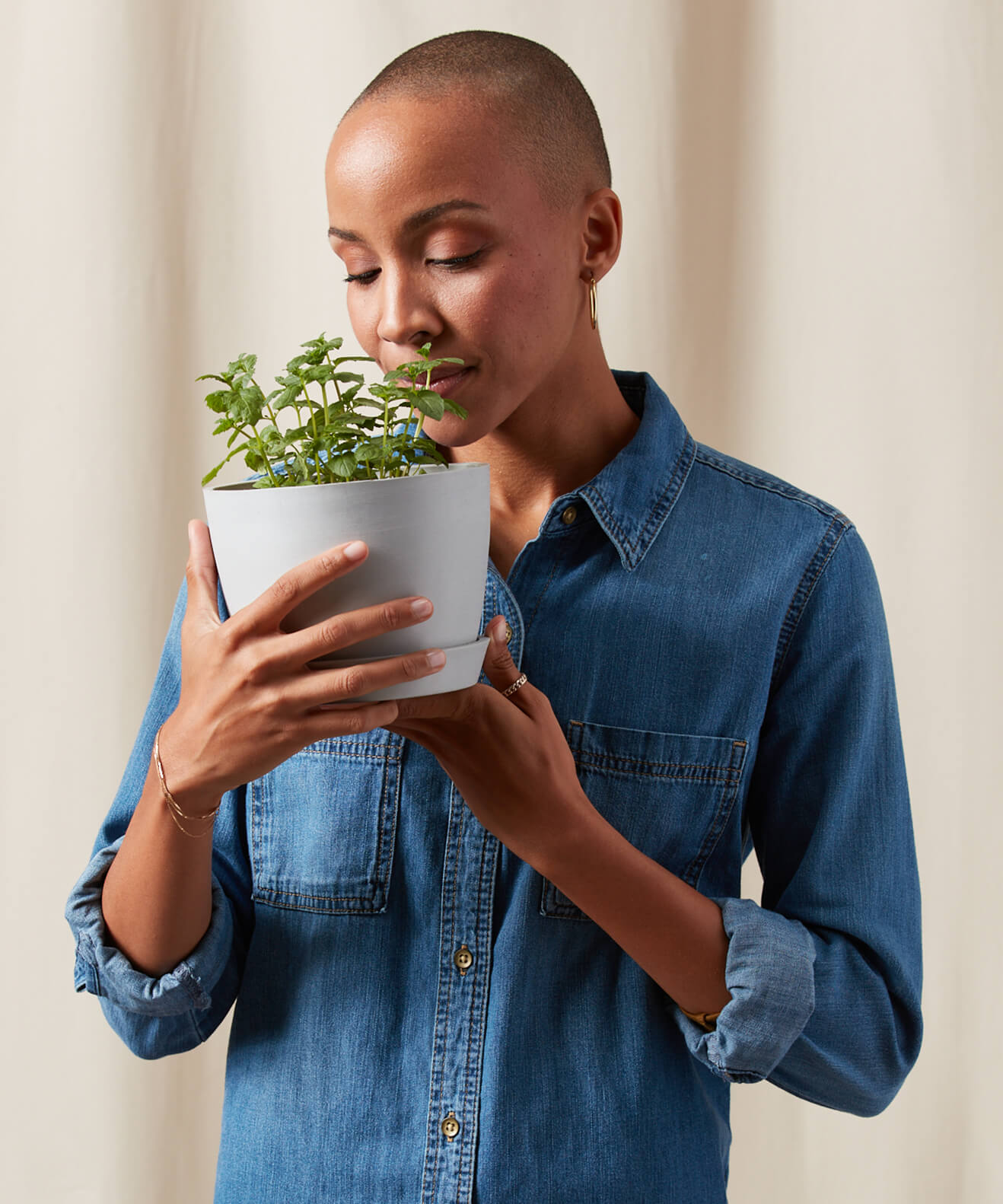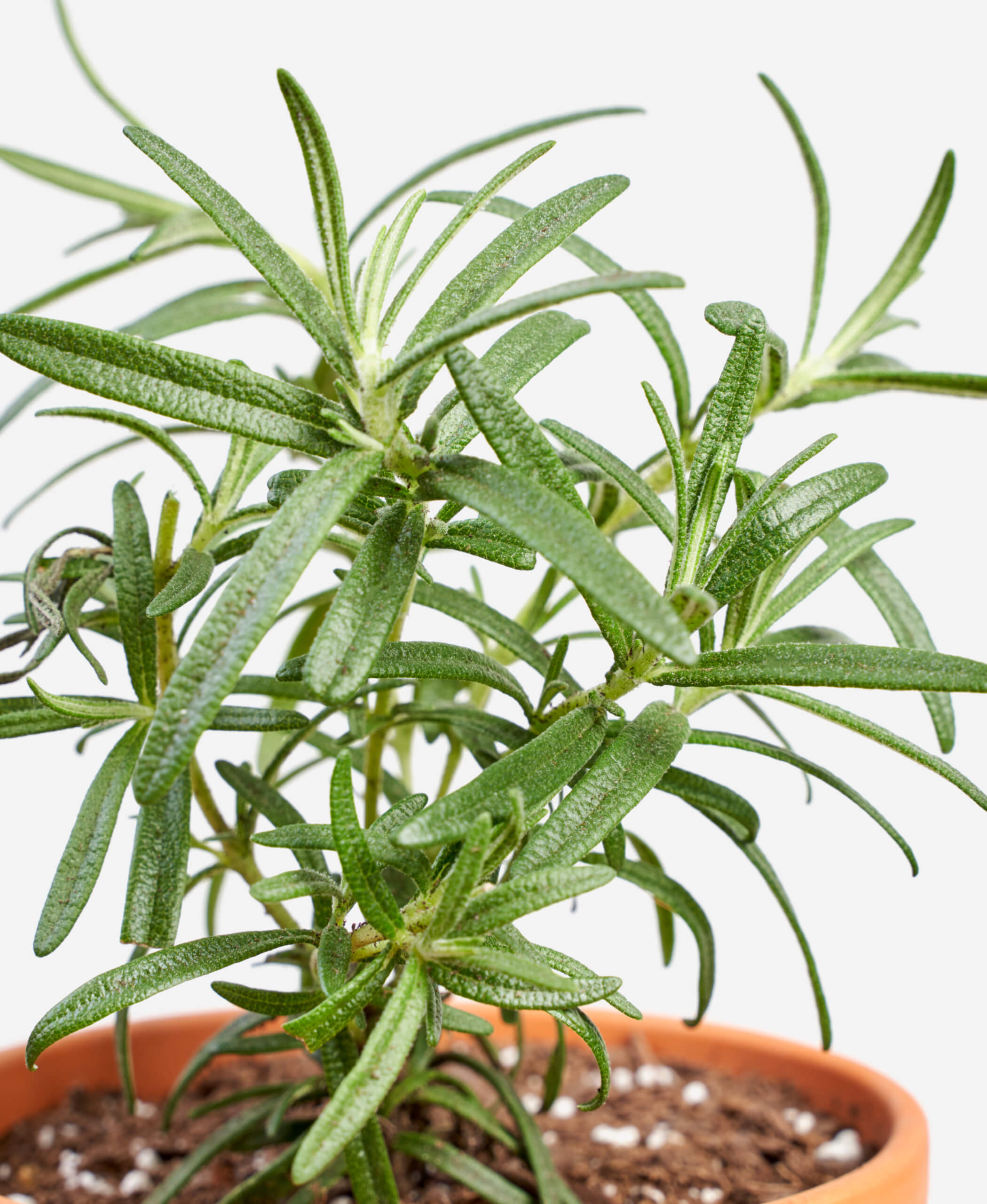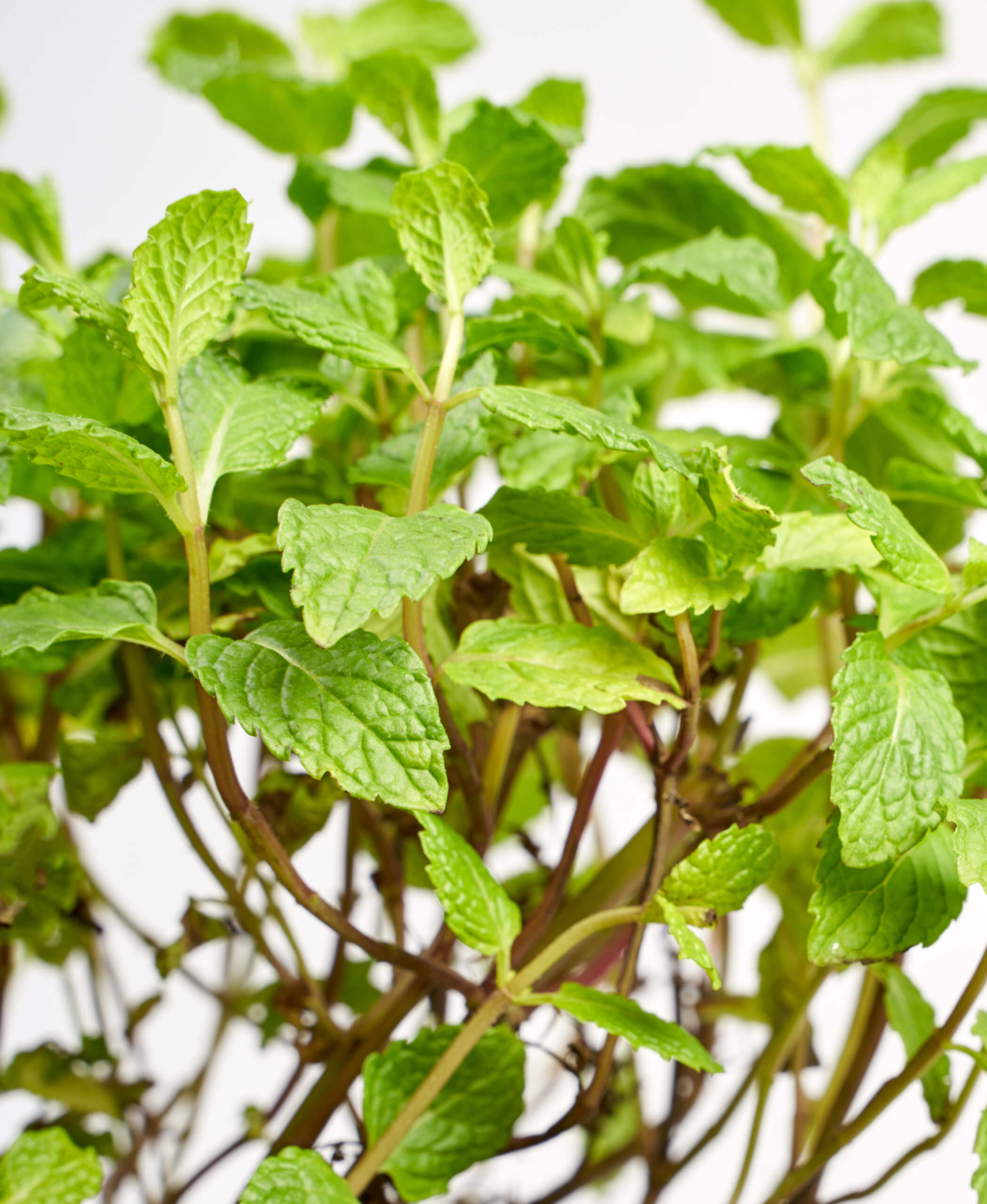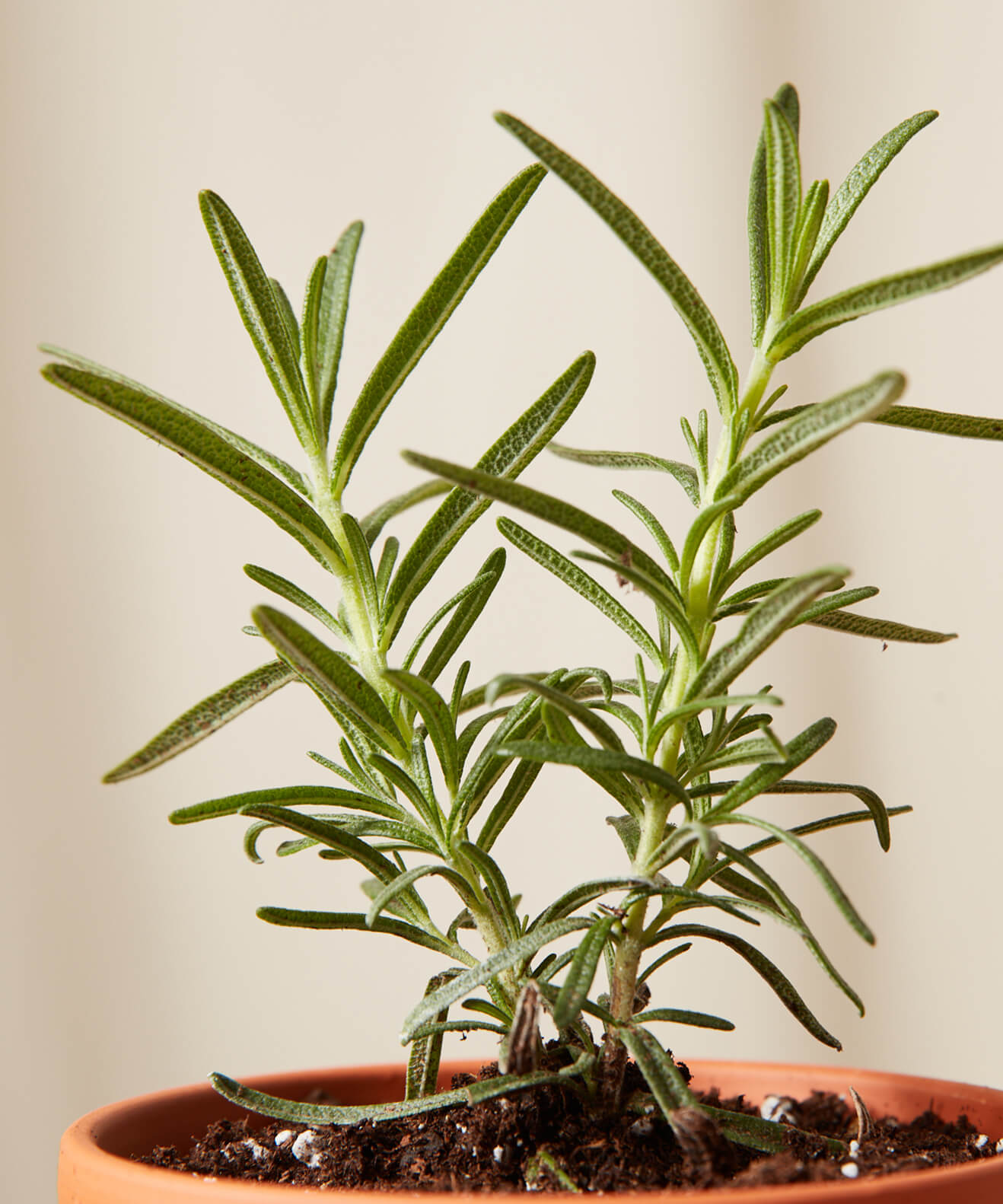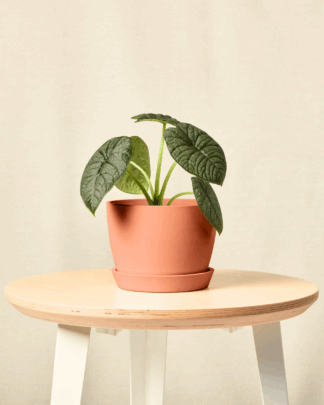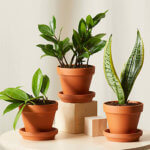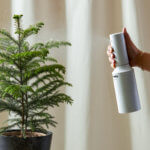How to care for your Herbs
Use these instructions to care for a Herbs. This guide will tell you how to water a Herbs; its light, temperature, humidity preferences and any additional care it might need to help it grow.
Basil
Your Basil will grow best in full sun, but will also do just fine indoors on a sunny windowsill or grow light. However, make sure it is receiving at least 6-8 hours of direct sun per day.
Do not allow the soil of your Basil to dry out completely. Water when the top 25% of soil is dry. During peak growth in the spring and summer, watering may be needed every day.
Basil will do best in temperatures between 60-90 degrees. Basil is sensitive to the cold, so make sure the temperature does not dip below 55 degrees.
If kept indoors, mist a few times per week.
Feed your Basil with a fertilizer for garden plants 1-2 times a month during spring and summer.
Basil is non-toxic. However, it is meant to be eaten by humans and not pets.
Cut your Basil at any point to enjoy it. Simply cut off the top of the plant, and it will regrow new leaves from that point. Do not worry about harming the plant, as cutting it actually encourages new growth.
Cat Grass
Your Cat Grass requires bright light to full sun. If grown indoors, place on a sunny windowsill or under a grow light.
Water your Cat Grass when the top 25% of soil is dry. Water until liquid flows through the drainage hole at the bottom of the pot and discard any water that has accumulated in the saucer. Do not allow the soil of your Cat Grass to dry out completely.
Your Cat Grass prefers a humid environment. Mist often if grown indoors.
60°-90° F
Feed once every month during the spring and summer with a fertilizer for edible plants.
Trim your plant occasionally just like you would normal grass! Cat Grass is non-toxic to cats and can aid in digestion and prevent hairballs.
Catnip
Your Catnip will grow best in full sun, but will be happy indoors on a sunny windowsill or under a grow light.
Do not allow the soil of your Catnip to dry out completely. Water when the top 25% of soil is dry. Water until liquid flows through the drainage hole at the bottom of the pot and discard any water that has accumulated in the saucer.
If kept indoors, mist a few times per week.
Your Catnip will do best in temperatures between 60-90 degrees.
Feed your Catnip with an organic fertilizer for garden plants once a month.
Catnip is safe for cats in small amounts, but some cats may have adverse reactions especially in large amounts. If this is the first time you are giving your cat catnip, ask your vet first or start with a very small amount. All cats react differently. According to the ASPCA, it can cause a digestive reaction. It makes some cats chill and some cats stimulated.
Trim your plant occasionally, this encourages new growth and keeps it fresh and healthy.
Chamomile
Your Chamomile plant requires 6-8 hours of bright light to full sun per day. If grown indoors, place on a sunny windowsill or under a grow light.
Water your Chamomile plant when the soil is completely dry. Water until liquid flows through the drainage hole at the bottom of the pot and discard any water that has accumulated in the saucer.
Your Chamomile plant prefers a humid environment. Mist often if grown indoors.
60°-90° F
Feed once every month during the spring and summer with a fertilizer for edible plants.
Chamomile is toxic to pets. They are meant to be eaten by humans and not pets.
Cut the blooms off your Chamomile Plant to use them in things like teas and oils.
Chives Onion
Your Chives will grow best in full sun, but will be happy indoors on a sunny windowsill or under a grow light.
Do not allow the soil of your Chives to dry out completely. Water when the top 25% of soil is dry. Water until liquid flows through the drainage hole at the bottom of the pot and discard any water that has accumulated in the saucer.
If kept indoors, mist a few times per week.
Your Chives will do best in temperatures between 60-90 degrees but they are cold-hardy.
Feed your Chives with a fertilizer for garden plants 1-2 times a month during spring and summer.
Chives are toxic to pets. They are meant to be eaten by humans and not pets.
Cut your Chives at any point to enjoy them. To keep your plant productive and with the best-flavored leaves, remove flowers as they form.
Cilantro
Your Cilantro Plant will grow best in full sun, but will also do grow in partial shade outdoors. If growing indoors, place on a sunny windowsill or under a growlight.
Do not allow the soil of your Cilantro Plant to dry out completely. Water when the top 25% of soil is dry. Water until liquid flows through the drainage hole at the bottom of the pot and discard any water that has accumulated in the saucer. During peak growth in the spring and summer, watering may be needed every day.
If kept indoors, mist a few times per week.
Your Cilantro Plant will do best in temperatures between 60-90 degrees.
Feed your Cilantro Plant with a fertilizer for garden plants 1-2 times a month during spring and summer.
Cilantro is non-toxic. However, it is meant to be eaten by humans and not pets.
Cut your Cilantro at any point to enjoy it. Simply cut off the top of the plant, and it will regrow new leaves from that point. Do not worry about harming the plant, as cutting it actually encourages new growth.
Lavender
Your Lavender plant requires 6-8 hours of bright light to full sun per day. If grown indoors, place on a sunny windowsill or under a grow light.
Water your Lavender plant when the soil is completely dry. Water until liquid flows through the drainage hole at the bottom of the pot and discard any water that has accumulated in the saucer.
Your Lavender plant prefers a humid environment. Mist often if grown indoors.
60°-90° F
Feed once every month during the spring and summer with a fertilizer for edible plants.
Please note: Lavender is toxic to cats and dogs.
Cut your Lavender at any point to enjoy it. Cut from the top of the plant. New leaves will grow from that point. Do not worry about harming the plant, as trimming encourages new growth. When grown indoors, Lavender may not produce flowers, but you can use the leaves of the plant to flavor and add aroma to dishes just as you would the flowers. Please note: Lavender is toxic to cats and dogs.
Lavender Tree
Place your lavender in bright light. You can find this in an unobstructed southern or western window that receives 6+ hours of direct light a day. During the warmer months, your lavender can be placed outside.
Water only when 100% of the soil volume is dry. Water thoroughly until you see if flow out of the drainage hole. Always discard any excess water in the saucer to discourage root rot.
Your lavender does well in average household humidity. However, if the air is very dry it will appreciate the occasional misting, pebble tray, or humidifier.
Your lavender will do best in temperatures between 60-90°F.
Feed your Lavender with a fertilizer for garden plants 1-2 times a month during spring and summer.
Edible plants for human consumption. Toxic to pets.
Cut lavender flowers or leaves at any point to enjoy the scent of the plant. Simply cut off the end portion of the stems. Don’t worry about harming the plant, as cutting will actually encourage new growth! When grown indoors in indoor lighting, lavender may not produce flowers. You can use the leaves of the plant to add flavor and aroma to dishes, just as the flowers would.
Lemon Balm
Your Lemon Balm will grow best in full sun, but will also do just fine indoors on a sunny windowsill or grow light. However, make sure it is receiving at least 6-8 hours of direct sun per day.
Do not allow the soil of your Lemon Balm Plant to dry out completely. Water when the top 25% of soil is dry. Water until liquid flows through the drainage hole at the bottom of the pot and discard any water that has accumulated in the saucer. During peak growth in the spring and summer, watering may be needed every day.
Your Lemon Balm Plant appreciates higher humidity. If kept outdoors, no extra humidity is needed, but if kept indoors, mist a few times a week.
Your Lemon Balm Plant will do best in temperatures between 60–90 degrees.
Feed your Lemon Balm Plant with a fertilizer for garden plants 1–2 times per month during spring and summer.
Lemon Balm is non-toxic. However, it is meant to be eaten by humans and not pets.
Cut your Lemon Balm at any point to enjoy it. Simply cut leaves from the top of the plant, and new growth will emerge from that point. Do not worry about harming the plant, as cutting it actually encourages new growth. Try not to let it flower — if you do see flowers, cut them off right away to keep your plant producing new leaves.
Lemongrass
Your Lemongrass will grow best in full sun, but will also do just fine indoors on a sunny windowsill or grow light. However, make sure it is receiving at least 6-8 hours of direct sun per day.
Do not allow the soil of your Lemongrass to dry out completely. Water when the top 25-50% of soil is dry. Water until liquid flows through the drainage hole at the bottom of the pot and discard any water that has accumulated in the saucer.
If kept indoors, mist your Lemongrass a few times per week.
Your Lemongrass will do best in temperatures between 60-90 degrees.
Feed your Lemongrass with a fertilizer for garden plants 1-2 times a month during spring and summer.
Edible plants for humans, toxic to cats and dogs
To use, harvest the bulbous stems, where the most flavor will be. The leaves can also be used for infusing in teas or soups.
Mint
Your Mint plant requires 6-8 hours of bright light to full sun per day. If grown indoors, place on a sunny windowsill or under a grow light.
Do not allow the soil of your Mint Plant to dry out completely. Water when the top 50% of soil is dry. Water until liquid flows through the drainage hole at the bottom of the pot and discard any water that has accumulated in the saucer. During peak growth in the spring and summer, watering may be needed every day.
Your Mint Plant will do fine in average humidity but appreciates higher humidity. If kept outdoors, no extra humidity is needed, but if kept indoors, mist a few times a week.
Your Mint Plant will do best in temperatures between 60-90 degrees.
Feed your Mint Plant with a fertilizer for garden plants 1-2 times a month during spring and summer.
Mint is non-toxic. However, it is meant to be eaten by humans and not pets.
Cut your Mint at any point to enjoy it. Simply cut off the top of the plant, and it will regrow new leaves from that point. Do not worry about harming the plant, as cutting it actually encourages new growth. Try not to let it flower – if you do see flowers, cut them off right away to keep your plant producing new leaves.
Orange Mint
Your Orange Mint plant requires 6-8 hours of bright light to full sun per day. If grown indoors, place on a sunny windowsill or under a grow light.
Do not allow the soil of your Orange Mint Plant to dry out completely. Water when the top 50% of soil is dry. Water until liquid flows through the drainage hole at the bottom of the pot and discard any water that has accumulated in the saucer
Your Orange Mint Plant will do fine in average humidity but appreciates higher humidity. If kept outdoors, no extra humidity is needed, but if kept indoors, mist a few times a week.
Your Orange Mint Plant will do best in temperatures between 60-90 degrees.
Feed your Orange Mint Plant with a fertilizer for garden plants once a month.
Orange Mint is edible for humans but toxic to cats and dogs.
Cut your Orange Mint at any point to enjoy it. Simply cut off the top of the plant, and it will regrow new leaves from that point. Do not worry about harming the plant, as cutting it actually encourages new growth. Try not to let it flower – if you do see flowers, cut them off right away to keep your plant producing new leaves.
Oregano
Your Oregano will grow best in full sun, but will also do just fine indoors on a sunny windowsill or grow light. However, make sure it is receiving at least 6-8 hours of direct sun per day.
Do not allow the soil of your Oregano to dry out completely. Water when the top 25% of soil is dry. During peak growth in the spring and summer, watering may be needed every day. Water until liquid flows through the drainage hole at the bottom of the pot and discard any water that has accumulated in the saucer.
If kept indoors, mist a few times per week.
Your Oregano Plant will do best in temperatures between 60-90 degrees.
Feed your Oregano with a fertilizer for garden plants 1-2 times a month during spring and summer.
Oregano is toxic to pets. It is meant to be eaten by humans and not pets.
Cut your Oregano at any point to enjoy it. Simply cut off the top of the plant, and it will regrow new leaves from that point. Do not worry about harming the plant, as cutting actually encourages new growth.
Parsley
Your Parsley plant requires 6-8 hours of bright light to full sun per day. If grown indoors, place on a sunny windowsill or under a grow light.
Do not allow the soil of your Parsley Plant to dry out completely. Water when the top 25% of soil is dry. During peak growth in the spring and summer, watering may be needed every day. Water until liquid flows through the drainage hole at the bottom of the pot and discard any water that has accumulated in the saucer
If kept indoors, mist a few times per week.
Your Parsley Plant will do best in temperatures between 60-90 degrees.
Feed your Parsley Plant with a fertilizer for garden plants 1-2 times a month during spring and summer.
Parsley is non-toxic. However, it is meant to be eaten by humans and not pets.
Cut your Parsley at any point to enjoy it. Simply cut off the top of the plant, and it will regrow new leaves from that point. Do not worry about harming the plant, as cutting it actually encourages new growth.
Pineapple Sage
Your Pineapple Sage requires 6-8 hours of bright light to full sun per day. If grown indoors, place on a sunny windowsill or under a grow light.
Do not allow the soil of your Sage plant to dry out completely. Water when the top 50% of soil is dry. Water until liquid flows through the drainage hole at the bottom of the pot and discard any water that has accumulated in the saucer.
If kept indoors, mist a few times per week.
Your Sage plant will do best in temperatures between 60-90 degrees.
Feed your Pineapple Sage plant with a fertilizer for garden plants once a month.
Sage is non-toxic. However, it is meant to be eaten by humans and not pets.
Cut your Sage at any point to enjoy it. Simply cut off the top of the plant, and it will regrow new leaves from that point. Do not worry about harming the plant, as cutting it actually encourages new growth.
Rosemary
Your Rosemary requires 6-8 hours of bright light to full sun per day. If grown indoors, place on a sunny windowsill or under a grow light.
Allow your Rosemary plant’s soil to dry out between watering. Your plant is quite drought tolerant. Water until liquid flows through the drainage hole at the bottom of the pot and discard any water that has accumulated in the saucer.
If kept indoors, mist a few times per week.
Rosemary will do best in temperatures between 60-90 degrees.
Feed your Rosemary with a fertilizer for garden plants 1-2 times a month during spring and summer.
Rosemary is non-toxic. However, it is meant to be eaten by humans and not pets.
Cut your Rosemary at any point to enjoy it. Simply cut off the top of the plant, and it will regrow new leaves from that point. Do not worry about harming the plant, as cutting will actually encourage new growth.
Sage
Your Sage requires 6-8 hours of bright light to full sun per day. If grown indoors, place on a sunny windowsill or under a grow light.
Do not allow the soil of your Sage plant to dry out completely. Water when the top 25% of soil is dry. During peak growth in the spring and summer, watering may be needed every day. Water until liquid flows through the drainage hole at the bottom of the pot and discard any water that has accumulated in the saucer.
If kept indoors, mist a few times per week.
Your Sage plant will do best in temperatures between 60-90 degrees.
Feed your Sage plant with a fertilizer for garden plants 1-2 times a month during spring and summer.
Sage is non-toxic. However, it is meant to be eaten by humans and not pets.
Cut your Sage at any point to enjoy it. Simply cut off the top of the plant, and it will regrow new leaves from that point. Do not worry about harming the plant, as cutting it actually encourages new growth.
Stevia
Your Stevia Plant requires 6-8 hours of bright light to full sun per day. If grown indoors, place on a sunny windowsill or under a grow light.
Do not allow the soil of your Stevia Plant to dry out completely. Water when the top 50% of soil is dry. Water until liquid flows through the drainage hole at the bottom of the pot and discard any water that has accumulated in the saucer. During peak growth in the spring and summer, watering may be needed every day.
If kept indoors, mist a few times per week.
Your Stevia Plant will do best in temperatures between 60-90 degrees.
Feed your Stevia Plant with a fertilizer for garden plants 1-2 times a month during spring and summer.
Stevia is non-toxic. However, it is meant to be eaten by humans and not pets.
Cut your Stevia at any point to enjoy it. Simply cut off the top of the plant, and it will regrow new leaves from that point. Do not worry about harming the plant, as cutting it actually encourages new growth. You will need to heat the leaves to release the sweet flavor. Boil Stevia leaves with tea leaves for a sweetened tea.
Thyme
Your Thyme requires 6-8 hours of bright light to full sun per day. If grown indoors, place on a sunny windowsill or under a grow light.
Do not allow the soil of your Thyme plant to dry out completely. Water when the top 25% of soil is dry. During peak growth in the spring and summer, watering may be needed every day. Water until liquid flows through the drainage hole at the bottom of the pot and discard any water that has accumulated in the saucer.
If kept indoors, mist a few times per week.
Your Thyme plant will do best in temperatures between 60-90 degrees.
Feed your Thyme plant with a fertilizer for garden plants 1-2 times a month during spring and summer.
Thyme is non-toxic. However, it is meant to be eaten by humans and not pets.
Cut your Thyme at any point to enjoy it. Simply cut off the top of the plant, and it will regrow new leaves from that point. Do not worry about harming the plant, as cutting it actually encourages new growth.
